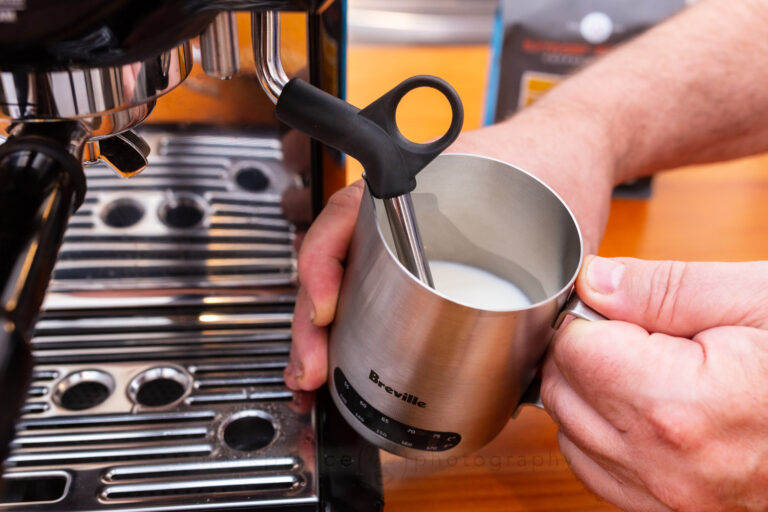Creating café-style coffee at home is both a joy and a skill. A critical step in crafting a rich and velvety latte or cappuccino is mastering the art of steaming milk on the Breville Barista Express. At first, I found my milk froth filled with large, uneven bubbles. However, with practice and refined technique, I achieved the perfect microfoam. Whether you're troubleshooting your steam wand or seeking to improve your skills, this guide will help you create professional-quality steamed milk. Uncover the brewing precision of the Breville Dual Boiler BES920XL review

Understanding the Steam Wand of the Breville Barista Express
The Breville Barista Express features a 360-degree swivel steam wand, offering versatility in milk steaming. Before beginning, ensure the machine has fully heated. The indicator lights will signal readiness. Using a steam wand that isn’t fully heated can compromise the quality of your foam, so patience is essential. Learn how this model blends convenience with innovation in the Breville Barista Touch Impress review
Preparing Milk for Steaming
The type of milk you use significantly affects the texture of your foam. Whole milk delivers a creamy, rich texture, while skim milk produces a lighter froth. Plant-based options like almond, oat, or soy milk can also yield excellent results, though adjustments to technique might be necessary based on their fat and protein content. Compare these top models to find your perfect match in the Breville Barista Express Impress vs Pro review
Use a stainless steel milk jug, which conducts heat efficiently and makes it easier to gauge temperature. For a single serving, a 12-ounce jug filled about one-third with cold milk allows ample room for expansion and prevents overheating. See what makes these machines stand out in the Breville Barista Pro vs Express review
Step-by-Step Instructions for Steaming Milk
Purge the Steam Wand
Start by purging the steam wand briefly to expel condensation. This step ensures you work with dry steam, which is essential for smooth microfoam.
Position the Steam Wand Correctly
Place the wand just beneath the milk’s surface, close to the spout of the jug, and tilt the jug slightly. This positioning facilitates the whirlpool motion, which is key to evenly textured milk.
Introduce Air (Stretching the Milk)
Turn the steam wand to full power and listen for a soft hissing sound, indicating air incorporation. Keep the wand near the surface during the first few seconds to stretch the milk and add air. Avoid over-aerating, as this leads to large bubbles instead of the fine microfoam you’re aiming for. Explore the key differences between these premium machines in the Breville Oracle vs Oracle Touch review
Texture the Milk
Once air has been added (usually within 3 to 5 seconds), submerge the steam wand fully by raising the jug slightly. Maintain the whirlpool motion to break down bubbles and achieve a glossy, silky finish. The milk should resemble wet paint in texture.
Monitor the Temperature
Feel the outside of the jug to monitor temperature; when it’s too hot to hold for more than a second, stop steaming. The ideal temperature is around 150°F (65°C). Using a thermometer can ensure precision, as overheating diminishes the milk’s natural sweetness.
Turn Off the Steam Wand
Before removing the steam wand, turn it off to avoid splashes. Carefully set the jug aside to prevent spills.
Final Steps to Perfect Milk Texture
Tap and Swirl the Milk
Gently tap the jug on a counter and swirl the milk to remove large bubbles. This step creates a smooth, glossy consistency, ideal for pouring.
Clean the Steam Wand
Wipe the wand immediately with a damp cloth and purge it again to prevent milk residue buildup. Regular cleaning ensures optimal performance and hygiene.
Pour the Milk
Tilt your cup and pour the milk steadily into the center of the espresso. Start from a higher point to mix the milk and espresso, then lower the jug to create a steady flow, which is crucial for latte art. Practice will allow you to master patterns such as hearts, tulips, or more intricate designs.

Tips for Enhancing Your Milk Steaming Technique
Practice Consistently
Steaming milk is a skill that improves with repetition. Experiment with techniques and milk varieties to refine your approach.
Use Fresh Milk
Fresh milk provides better protein content for foam creation. Ensure it’s within its expiration date and avoid milk that’s been opened for too long.
Experiment with Milk Alternatives
Barista-style oat milk, soy, and almond milk each froth uniquely. Adjust your technique to accommodate their specific characteristics for the best results.
Mistakes to Avoid
- Over-Aeration: Excessive air creates coarse, large bubbles. Aim for a gentle hissing sound during the stretching phase.
- Overheating: Milk scalds at 170°F (77°C), resulting in a burnt flavor. Stop steaming before reaching this point.
- Neglecting to Clean: Failing to clean the steam wand can lead to clogs and hygiene issues. Always wipe and purge the wand after use.
Exploring Latte Art
Once you’re comfortable with steaming milk, try your hand at latte art. Start with basic designs like hearts and tulips, and progress to more intricate patterns. The satisfaction of adding a personal artistic touch to your coffee is well worth the effort.

Conclusion: Master the Art of Steamed Milk at Home
Perfecting the technique of steaming milk with the Breville Barista Express elevates your home coffee game. With consistent practice and a clear understanding of the process, you can create perfectly textured milk for lattes, cappuccinos, and latte art.
Whether you’re starting your morning ritual or exploring creative coffee presentations, mastering steamed milk is a rewarding skill. Grab your milk jug, fire up your Breville, and enjoy the satisfaction of crafting café-quality beverages right in your kitchen.
